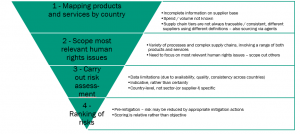Broadening the understanding of human rights risks: working with the M&S property team
Posted by Stuart Bell

In most companies human rights risk assessment resources are being directed to spotting modern slavery within supply chains. But, important as this is, there is a danger that other salient human rights risks, as well as those that are located outside the supply chain context, are being overlooked or at least under-prioritised.
UK retailer Marks & Spencer has taken a lead in adopting a broader and deeper approach to human rights risk assessments, and we have been pleased to provide various levels of specialist support, through helping to prioritise company-wide salient human rights issues (as reported in M&S’s Human Rights and Modern Slavery reports), and also by assisting a variety of business units, not only the food and clothing supply chains, to think about and address their most relevant human rights issues.
In particular, during 2017 and early 2018, we worked with the M&S Property and Retail teams (who are responsible for maintaining and operating shops) to identify key human rights and modern slavery risk issues and action points. To our knowledge, this makes M&S one of the first major companies to have extended its human rights risk assessment and overall due diligence processes in a concerted way to these business functions and to publicly report on it.
In this blog by Stuart Bell and Laura Curtze, we want to take the opportunity to share some insights from this work.
Lesson 1: Use risk assessment to fill information gaps
Building onto our proven approach to human rights risk assessments, the work involved a number of steps. The first one was to identify the products and services these teams used – that is, to try and think about all the things that go into building, fitting out and operating a retail space. As you might expect, the result was an eclectic list including material supplies such as light fittings, timber or refrigeration, through to services such as facilities management, security or architects.
Teams were asked for information on where they knew suppliers or contractors to be based or where their supply chains originated. In doing so, the process provided a valuable opportunity to the M&S Property and Retail Groups to update, complement and review supply chain information, which is a crucial first step in developing due diligence procedures, especially in supply chains and business areas that may not otherwise receive as much attention.

Lesson 2: Risk assessment and prioritisation as a basis for action
Next, we identified a short list of the most relevant rights likely to be impacted by these activities. There was a focus on various labour rights due to the prominence of labour-intensive manufacturing processes and service provision, but we also considered other rights issues, such as liberty and security of the person – relevant for security contractors.
The next step was to score each impacted right and each country where services were being procured or materials sourced, using our proprietary human rights analytical database. The resulting risk assessment, ranking human rights risks by sourcing countries, served as the basis for identifying areas of focus for action and next steps.
This is important, because human rights due diligence doesn’t end once you’ve assessed your risks – you’re only just getting started. Mitigating actions were developed for priority areas that sought to either fill-in information gaps, strengthen existing assessment processes or build internal capacity to analyse information coming from suppliers and contractors as well as areas in which additional support could be provided to service and product suppliers.
Lesson 3: Engage the team!
Property and Retail Human Rights practitioners were involved at each stage, culminating in two workshops with contract managers which validated the assessment results and developed practical actions that could be built into existing management controls and procurement processes.
The importance of this level of participation is a key learning from our wider experience of supporting human rights strategies within companies, as this leverages the existing knowledge of practitioners. Not only are many human rights risks already known (though they may not be recognised or termed as such) to operational teams, but mitigation actions will only stand a chance of being implemented if they can be integrated into day-to-day workloads.